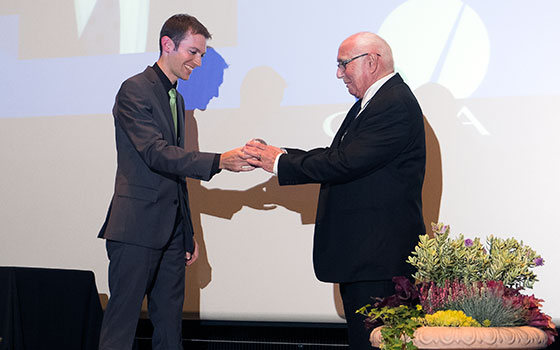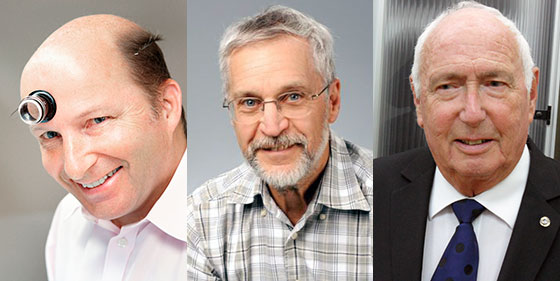
They include a designer of innovative horological mechanisms, an inventor of atomic clocks, and the head of a laboratory which is indispensable to the watch industry... a profile of the 2014 Gaia Award winners.
The twentieth edition of the Gaia Award was held on 18 September this year at the International Museum of Horology (MIH) in La Chaux-de-Fonds. Presided for the first time by the museum’s new curator Régis Huguenin-Dumittan, the event brought together the world of watchmaking, friends of the museum and communal authorities.
Created in 1993 by the MIH and the only event of its kind, the Award singles out the best of the best from among those who have contributed to the enown of horology in terms of its history, its techniques or its industrial success. The Gaia Award singles out three categories of achievement.
Craft and design
The craft and design category was created to pay tribute to bold and creative watchmakers sometimes working in relative anonymity, their names being discreetly associated with large firms. Its 2014 winner is Kari Voutilainen.
Born in 1962 in Rovaniemi (Finland), Kari Voutilainen trained at the world-renowned Tapiola School of Watchmaking in Finland and followed this with a course in business studies. An independent watchmaker in Finland, he travelled to Switzerland in 1988 initially to attend a refresher course at WOSTEP (Watchmakers of Switzerland Training and Educational Program) in Neuchâtel. He then attended classes devoted to complicated watches. In 1990, he was hired by Parmigiani to work on the restoration of exceptional complicated watches. He was also involved in the design of unique and original timepieces.
After teaching at WOSTEP between 1999 and 2002, Kari Voutilainen founded the Voutilainen Artisan d’horlogerie d’art atelier in Môtiers, in the Val-de-Travers. Three years later, he presented his works for the first time at Baselworld. A member of the Academy of Independent Watch Designers (AHCI) since 2006, he was voted watchmaker of the year by the Finnish Watchmakers’ Association in 2007. In 2013, he won the award for best men’s watch at the Grand Prix d'Horlogerie de Genève.
Today, the Voutilainen Artisan d’horlogerie d’art atelier employs fifteen people and produces around 45 watches a year – unique timepieces or strictly limited editions – following the precepts of watchmaking tradition and quality craftsmanship.
History and research
Individuals honoured for their contribution to the history of watchmaking and its techniques, or more broadly the measurement of time, either through written works or museum-based activities, come from very different educational backgrounds. The aim of this category is to showcase their achievements, since they often work behind the scenes to develop this body of knowledge. Pierre Thomann is the 2014 winner in this classification.
Born in 1946, a physicist and doctor of science who studied at the Swiss Federal Institute of Technology Lausanne (EPFL), Pierre Thomann continued his academic training with a two-year post-doctoral placement in the United States supported by a grant from the Swiss National Science Foundation. On his return to Switzerland he conducted a number of industrial research projects on new atomic clocks, firstly with the Asulab watchmaking group and later with Oscilloquartz, both based in Neuchâtel. In 1990 he joined the Neuchâtel Cantonal Observatory, a research and development laboratory specialising in atomic clocks, where clocks intended for the GALILEO satellite navigation system (European equivalent of GPS) were created. Here, on behalf of the National Institute of Metrology (METAS), he developed a primary reference clock based on a fountain of laser-cooled caesium atoms.
Appointed deputy scientific director of the Observatory in 1995, associate professor at Neuchâtel University in 2002, and finally a full professor at the same university when the Time-Frequency Laboratory (TFL) was created in 2007, Pierre Thomann conducted research in different fields and applications of atomic physics, optics and atomic clocks. Staff at the TFL, initially five employees, quadrupled during its first four years of existence thanks in particular to external funding from the Swiss National Science Foundation, METAS and the European Space Agency, through the Swiss Space Bureau.
Pierre Thomann was singled out in 2008 for the European Time-Frequency award. He sits on several international time-frequency metrology committees as an expert. He retired in 2011 but continues to take part in one of the TFL research projects, namely work on the development of a Swiss reference clock.
Spirit of Enterprise
Where would watchmaking be without the entrepreneurial drive which, over the centuries, has served to consolidate and promote this art? From a craft activity, it became an industry with all that entails, from production to distribution of the end product. In past centuries watchmakers of genius have fuelled this determination to promote their works and it is fitting to acknowledge and honour the women and men who today pursue the same ends, to showcase the quality of their products, and above all initiate new research to improve timepieces. This year, the Spirit of Enterprise award was won by Henri Dubois.
Born in 1936 in La Chaux-de-Fonds, Henri Dubois spent his childhood in Le Locle and as a young man was apprenticed to a chemist’s shop (1952-1956). In 1960, after qualifying as a chemist, he became head of the chemistry and electroplating laboratories of the firm Prochimie in La Chaux-de-Fonds. In parallel with his professional activity he was instrumental in launching vocational training in electroplating at the college of arts and crafts in La Chaux-de-Fonds, where he taught technology and chemistry. In 1975, he took charge of the laboratory operated by the firm Portescap. In the wake of the watch industry crisis and the redundancies that came with it, he suggested placing the laboratory’s resources at the service of firms active in surface treatments (electroplaters, subcontractors, manufacturers of hands, dials, cases and bracelets). Noting at the time that in French-speaking Switzerland there were no providers offering independent analysis in the fields of electroplating and metallography, and realising the extent to which local firms had need of such expertise in these fields, he took the decision to open his own laboratory.
From 1977, the Laboratoire Dubois consisted of a team of three people offering services in various fields (electroplating consultancy, surface treatment tests, metallographic cross-sections) for the watch industry and its ancillary branches, as well as jewellers and manufacturers of luxury products (spectacles, leather goods). He quickly assembled a team of technicians and scientists that allowed him to expand the scope of its activities. In 1978, by which time the laboratory’s workforce had risen to 10, he added industrial chemistry and corrosion and wear tests to the range of services offered, a step which marked the advent of quality control.
The year 1985 was a turning point for the laboratory in terms of watchmaking. The Federation of the Swiss Watch Industry broke away from its reliability testing centre. Realising the parallels between that company and his own, Henri Dubois agreed to take it over. Thereafter, the laboratory was able to offer extremely rigorous operational checks on timepieces as well as a large panoply of tests (magnetism, shocks, water-resistance, etc). Collaboration with the watch industry grew in importance in 1992 with the takeover of the Controle technique des montres (CTM), a government office which closed its doors.
These developments led to a concentration of horology-related activities within a new company, Chronofiable SA, founded in 1993, which in 2003 was integrated into the legal entity of Laboratoire Dubois. Another new activity was added to this range of services: tribology.
To broaden the expertise of his company still further, Henri Dubois decided to obtain ISO 17025 accreditation for the Laboratoire Dubois. Therefore in February 1995, the latter became the first Swiss test laboratory to be accredited for metallography and materials testing and inspection. With his many years of experience and more than thirty staff, Henri Dubois saw his laboratory become a key partner in numerous industrial sectors, while at the same time maintaining and developing a particularly high level of competency in the watch industry.
In 2003, Henri Dubois was presented with the ERNE Award for “exceptional performance” by the Foundation for the Development of Surface Treatments. In 2012, he handed over the reins of the Laboratoire Dubois to his son, Patrick, while remaining a member of the board of directors and the firm’s honorary president. In the course of his career Henri Dubois accepted many other responsibilities: he was a member of the board of the ASRH (Swiss watch industry research association) and Swiss delegate to the “Nickel” European working group involved in preparation of the standard EN 1811 (measurement of the release of nickel for products in direct contact with the skin).
It should be noted that future laureates may not nominate themselves as candidates for the Gaia Award. Recommendations must be submitted by third parties. Members of the jury consisting of Swiss and foreign personalities from a variety of backgrounds (culture, journalism, science and economics) then designate the laureates. This year’s jury included three members of the MIH: Régis Huguenin-Dumittan, curator and president of the jury, Nicole Bosshart, deputy director, and Jean-Michel Piguet, deputy curator. Other members were: Henry John Belmont, watch industry consultant; Jean-Pierre Brügger, CEO of CIFOM (inter-regional vocational training centre, La Chaux-de-Fonds); Daniel Droz, a journalist with the francophone Swiss press agency; Hans Erb, Timesign; Estelle Fallet, chief curator and head of the history department at Geneva Museum of Art and History; Joël A. Grandjean, editor in chief of the magazine Heure Suisse; Morghan Mootoosamy, curator of Le Locle Watch Museum, Château des Monts; Michel Parmigiani, CEO of Parmigiani Fleurier; Emmanuel Vuille, CEO of Greubel et Forsey, and Janine Vuilleumier, editor in chief of the Revue FH.

2014 laureates: Kari Voutilainen, Pierre Thomann and Henri Dubois
October 02, 2014


 News
News